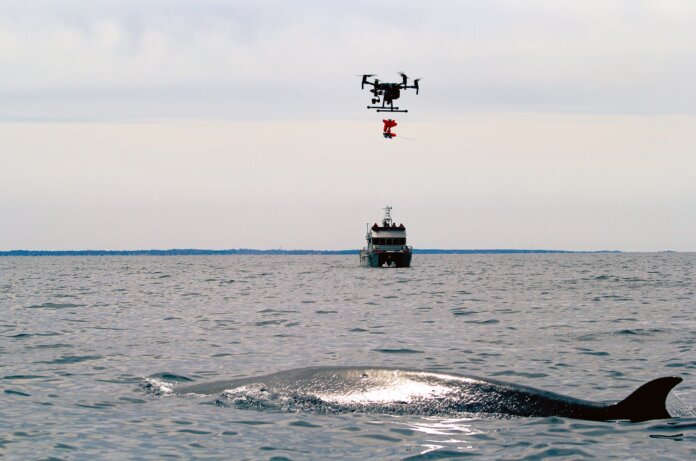The Bureau of Ocean Energy Management (BOEM) and the National Oceanic and Atmospheric Administration’s (NOAA) Stellwagen Bank National Marine Sanctuary have successfully tagged 14 sei whales in waters offshore Massachusetts with digital acoustic technology. This is the first time researchers have successfully tagged an endangered species in the United States using an unmanned aerial vehicle (UAV).
The collected data will shed important light on the whales’ acoustic behavior, which researchers will use to inform mitigation strategies – including passive acoustic monitoring – to protect this endangered species from the potential impacts of offshore wind energy activities.
“BOEM is pleased to be able to fund this important research. Our Environmental Studies Program looks for innovative solutions to resource management challenges,” says Jacob Levenson, BOEM’s marine biologist. “Using UAVs allows scientists to collect data in a way that is safer for both the whales and researchers.”
Very little is known about the sei whale, which is one of the most endangered large whales in the North Atlantic. Understanding how the whales behave and use their habitat is critical for BOEM to assess potential impacts resulting from bureau-permitted offshore activities and ensure responsible offshore wind energy development.
Digital acoustic tagging is a component of a larger BOEM study into the Spatial and Acoustic Behavior of Endangered Large Whales to address gaps in information on a variety of endangered large whale species – including sei, North Atlantic right and fin whales – to better inform offshore wind energy area selection. UAVs enable researchers to target specific animals in a group or conduct multi-group taggings, and the collected data will also aid in conservation efforts.
“The use of UAVs to tag whales is the first major innovation related to attaching tags to whales,” comments Dr. David Wiley, research ecologist at Stellwagen Bank National Marine Sanctuary. He has used various suction cup-based, computer-equipped tags to study the underwater behavior of whales for almost 30 years.
BOEM’s endangered large whale study is a collaboration with the Stellwagen Bank National Marine Sanctuary, Syracuse University, University of Michigan, Ocean Alliance and Blue World Research Institute. OceanX funded the development of the Ocean Alliance UAV-based tag deployment system. Additional funding was provided by the Volgenau Foundation and the National Marine Sanctuary Foundation. Funding for Ocean Alliance was provided by the Pamela K. Omidyar Trust and the Sarah K. de Coizart Tenth Perpetual Trust.
UAV work was conducted under Permit No. 18786-06 issued to the Marine Mammal Health and Stranding Response Program, under which Dr. Wiley is a co-investigator. All other activities were conducted under NMFS Permit No. 18059 issued to Dr. Wiley.




